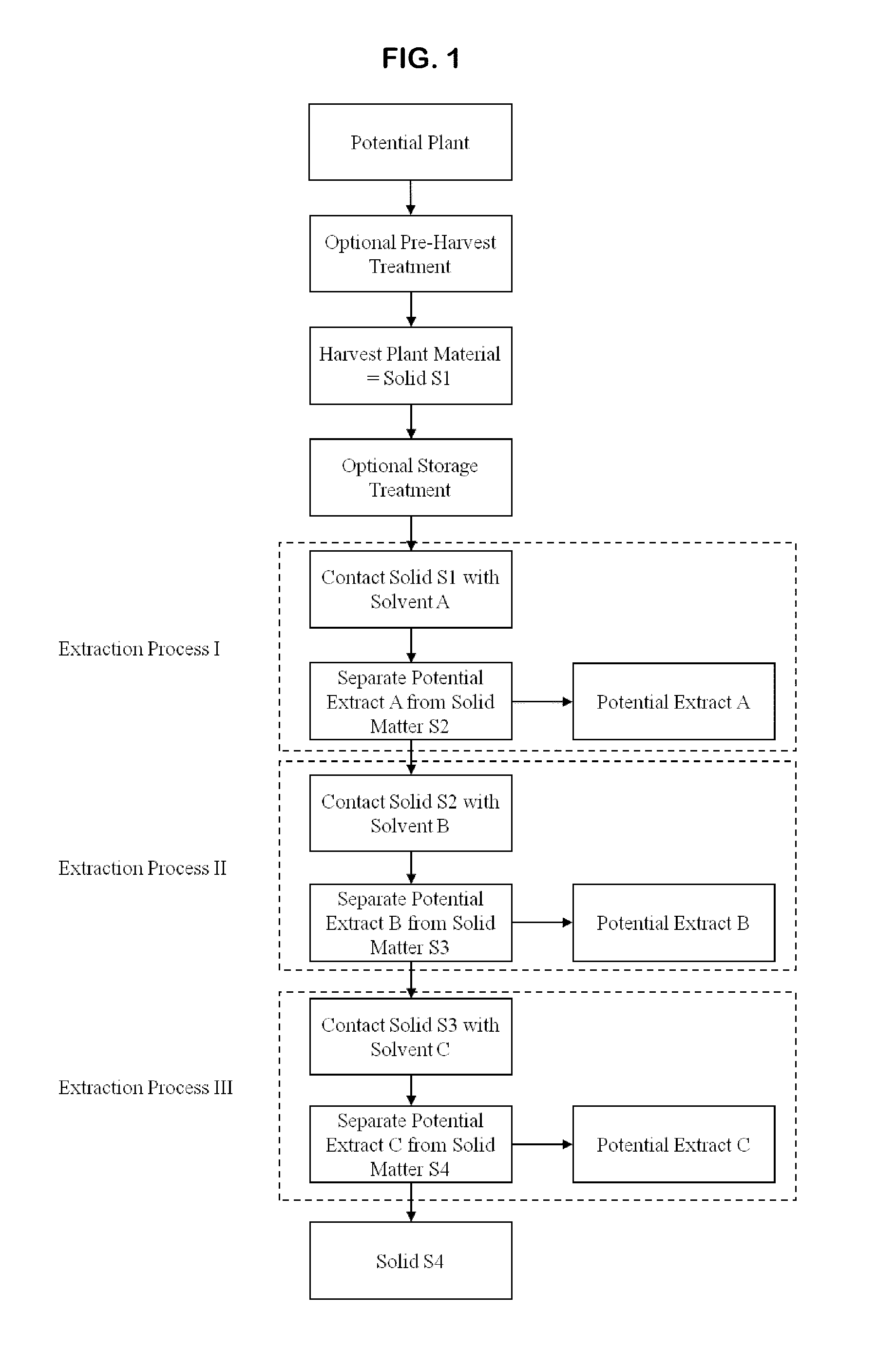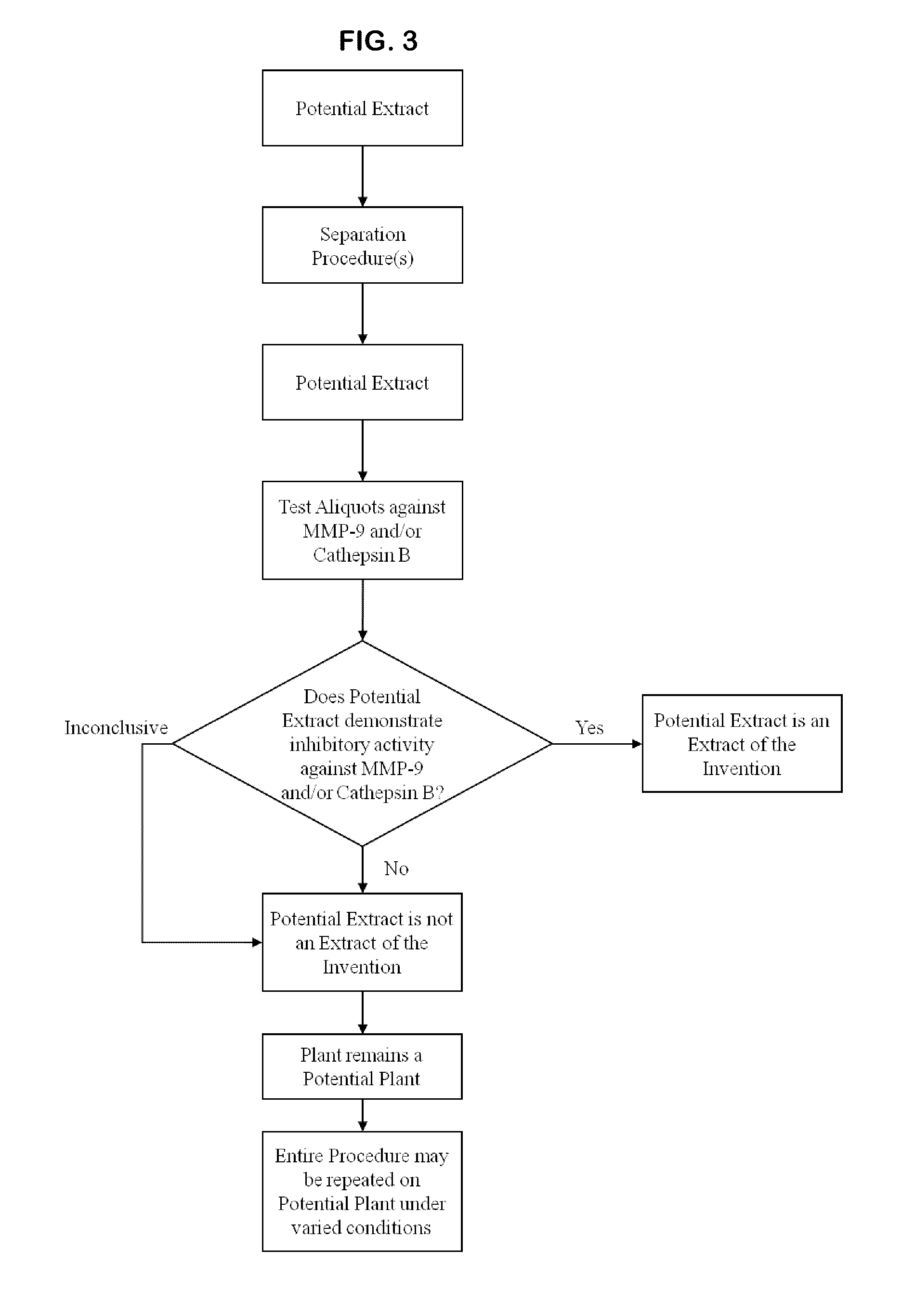Methods and therapeutic compositions comprising plant extracts for the treatment of cancer
a technology of plant extracts and compositions, applied in the field of cancer therapy, can solve the problems of poor outcome, unsatisfactory side effects, and inability to administer to overweight individuals,
- Summary
- Abstract
- Description
- Claims
- Application Information
AI Technical Summary
Benefits of technology
Problems solved by technology
Method used
Image
Examples
example i
Preparation of Stressed and Non-Stressed Plant Extracts (Method A)
[0263]Pre-Harvest Treatment: Aerial parts of a living plant were sprayed with an aqueous solution of gamma linolenic acid (6,9,12-Octadecatrienoic acid, Sigma L-2378) (stress G) or arachidonic acid (5,8,11,14-Eicosatetraenoic acid, Sigma A-3925) (stress A) (400 μM in water with 0.125% (v / v) Triton X-100) to completely cover the leaves. Twenty to twenty-four hours after the stress, plants were harvested.
[0264]Harvest Solid S1 and Optional Storage Treatment: Twenty to twenty-four hours after the stress, more than 4 grams of leaves, stems, fruit, flowers, seeds or other plant parts were harvested and frozen immediately in dry ice, then transferred as soon as possible to a −20° C. freezer until use. Plant materials may be stored at −20 C for a long period of time, more than a year, without losing inhibitory activity. Temperature was monitored to ensure a constant condition.
[0265]Stressed and non-stressed plant specimens w...
example ii
In Vitro Enzyme Inhibition Assays
[0272]The inhibitory activity of sample compositions towards human MMP-9 or human cathepsin-B were determined using either fluorogenic substrates or the FASC assay.
Measurement of Human MMP-9 Activity with Fluorogenic Peptidic Substrates
[0273]MMP-9 was purified from natural sources (THP-1 cells (ATCC, Manassas, Va.) for MMP-9) as described in literature and based on protocols found in I. M. Clark: “Matrix metalloproteinases protocols”, Humana Press (2001). Proteolytic activity of MMP-9 was evaluated with the assay based on the cleavage of auto-quenched peptide substrate: (MCA-Pro-Leu-Gly-Leu-Dpa-Ala-Arg-NH2.TFA [Dpa=N-3-(2,4-dinitrophenyl)-L-2,3-diaminopropionyl]); In the intact peptide, Dpa or DNP quenches the MCA fluorescence. Cleavage of the peptide causes release of the fluorescent MCA group which was then quantitated on a fluorometer (Gemini X S, Molecular Devices, Sunnyvale, Calif.). The assay was performed in TNCZ assay buffer (20 mM Tris-HCl; ...
example iii
Exemplary Purification of Inhibitory Activity Found in an Extract
[0280]Extracts can be separated by HPLC on an Agilent 1100 system (San Fernando, Calif.). Briefly, 100 μL of a crude extract prepared as described in Example I can be applied on a C18 reverse-phase column (Purospher RP-18 5 μm, 4.0×125 mm (HP), Agilent, San Fernando, Calif.). Elution of compounds is achieved with a linear gradient of 10-85% acetonitrile. Fractions are collected, evaporated, resuspended in aqueous buffer and reanalysed for their inhibition activity on specific enzymes as already described. Fractions of interest (demonstrating a biological activity) can be reisolated at a larger scale for further analysis and characterisation.
PUM
 Login to View More
Login to View More Abstract
Description
Claims
Application Information
 Login to View More
Login to View More - R&D
- Intellectual Property
- Life Sciences
- Materials
- Tech Scout
- Unparalleled Data Quality
- Higher Quality Content
- 60% Fewer Hallucinations
Browse by: Latest US Patents, China's latest patents, Technical Efficacy Thesaurus, Application Domain, Technology Topic, Popular Technical Reports.
© 2025 PatSnap. All rights reserved.Legal|Privacy policy|Modern Slavery Act Transparency Statement|Sitemap|About US| Contact US: help@patsnap.com



